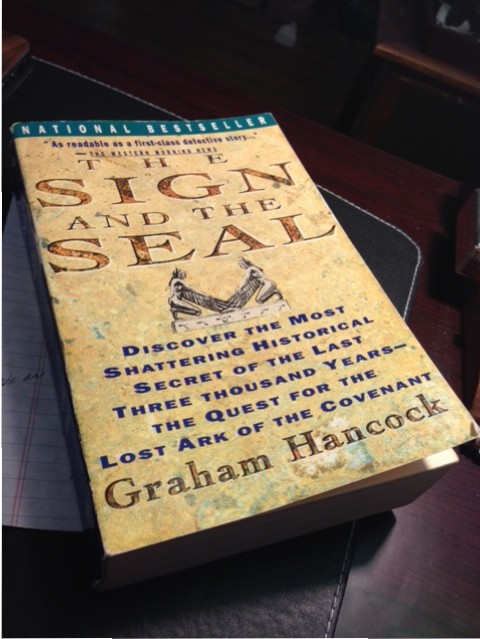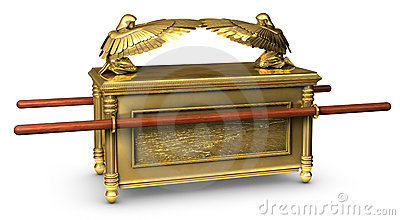The Sign and the Seal
by Graham Hancock
Touchstone/Simon & Schuster, 1992, Trade
600pp, $14.00, Index, Reference Notes,
2 maps, 61 b&w photographs
A Review by Gene Stewart
Then a world economics reporter, the East Africa correspondent for The Economist, and author of several books about Africa, Hancock first visited Axum, Ethiopia in 1983, shortly after civil war died down enough to allow foreign nationals to visit again. It was then he experienced his first tingle of interest in the mysterious, and mysteriously lost, Ark of the Covenant, the one mentioned in both the Bible and Indiana Jones movies. This began a decade of searching for him, as he traced tantalizing leads, whispered hints, and decoded clues. He admits he was led from his beaten path of prior success but to judge from the result, he chose wisely.
He began with surveying the Parzival and Holy Grail stories, reading up on King Arthur, the Knights Templar, and other old tales of powerful, god-touched artifacts and revealed hidden knowledge. As patterns emerged, Hancock started piecing together a rational, if untested, time-line for the Ark, the core talisman of the Moses-led Jews, the Levites, the early Christians, and so much else, to have vanished without so much as a mention in the array of records. How had such a thing happened, why, and where might such a holy relic have been hidden?
Hancock writes vividly of his dusty, exhausting experiences traveling in places, through conflicts, most of us would avoid. He is excellent in his descriptions and compelling in his narrative; the book reads like an adventurous mystery novel, yet it’s reporting, not fiction. Being open to new things, be they cultural or conceptual, allows Hancock freedom of action and logic perfect for unraveling this great mystery.
He wants to know. How he goes about finding out, the scholars he consults, the places he investigates, and the discoveries he makes, combine into a cogent, trenchant work that cost Hancock much but gained him far more. Example: His marriage deteriorated during the grueling years of researching this book, done on his own ticket. Example: His first solo non-fiction work, The Sign and the Seal became an international best-seller and allowed him to continue expanding his life inwardly and outwardly, with further pivotal books on such topics as aqua-archaeology and ayuhuasca.
Intelligence shines from every page, his sentences being balanced and clear. He presents information systematically and keeps the reader in context, with just enough reminder or nudge when called for. We see the mystery as he discovered and unfolded it, sharing the thrill of making links and confirming them.
While he openly admits he is neither academic nor scholar, he demonstrates remarkably wide knowledge and knows how to delve deeply when the need arises. These abilities add up to persuasive, rational argument awaiting only the picayune detail of scientific sifting, much of which already done by Hancock.
Definitive is a description remaining to be claimed but I know of no other work, scholarly or popular, that comes even close to The Sign and the Seal in regards to tracing the origins, aspects, and fates of the Ark of the Covenant. What it was is understandable from reading this book. How it may have worked is strongly hinted at, too.
Hint: Not mentioned in this book, which was written long before they happened, are replication experiments performed by many engineers and college classes. By constructing a replica using the exact specifications from the Bible, and they are quite explicit, one ends up with what is today recognized as a capacitor. It builds up and stores electro-static energy which can release through the cherubim mounted atop the box lid. It gave off sufficient volts and amperage to be fatally dangerous and college classes have had to dismantle their replica arks as a safety precaution.
Now imagine a powerful capacitor, decorated with carved gold, able to deliver fatal shocks, as happened to Aaron’s sons when they ill-advisedly got too close, imagine such a device’s supernatural qualities for people living 2000 years ago in the desert. They’d be justifiably terrified and unable to explain it.
Fortunately, the man who built it, Moses, was steeped in esoterica and other hidden arts, having been raised as a Pharaoh’s son, which automatically made him a priest of the hidden orders. He’d have learned the magic illusions he used to such good effect to keep his rabble in line for the forty years of indoctrination and training needed to whip a horde into an army, which then successfully challenged and conquered an established military.
Aaron, his son, was taught such matters, too, but his own sons apparently got cocky or had not yet properly been taught and so paid the price of being electrocuted by a huge discharge.
Add to all this electrical mayhem other evidence that the Ark also contained strong radioactivity and one can see how and why it was worshipped as a seat of a god, as a place where a god manifested — as the blue-white spark of degaussing electrostatic charge, perhaps?
Yet letting such an astounding item simply vanish from the records without comment is a mystery no one, until Hancock, has solved. He sifts out reasons, then tracks down evidence to deny or support his speculations, always allowing the evidence to lead him. In this way, he comes at last to gratifying steps and satisfying conclusions in this persuasive, rational book.
Along the way he even offers a reasonable explanation of why both the Ancient Egyptian and Ancient Sumerian civilizations started at their apexes, only slowly to wind down, with no prior hint of growth before they suddenly appeared. Both, he finds, are rooted in a third civilization, already at an apex with monumental architecture and world-class artistry, transplanted to the general Egypt/Sumer area by a catastrophe, very possibly a flood. Yes, echoes of Atlantis without the crazy shouts of aliens; it’s even supported by much archaeological evidence, albeit considered fringe so far by orthodox, received-wisdom defenders.
In this book we also trace the Jewish diaspora, with strong evidence presented concerning where the oldest Jewish culture ended up, and remained virtually untouched. To this day, practices long expunged by the Jerusalem-centered Jewish rituals continue unaffected, deep inside Ethiopia’s war-torn, shattered shadows.
If archaeological matters interest you, and if this kind of adventure of logic, hardship, and discovery appeals, then The Sign and the Seal is strongly recommended. Make sure to get a new copy; mine’s burning up from age, an archaeological relic in and of itself.
/// /// ///


